While quartz has undoubtedly been the recent success story for sales of worktops, it has a way to go to dominate the market. Laminate still has the greatest share of the worktop market.
Product director for worktops at IDS Ian Holmes offers some statistics on market share:“Sales of laminate are consistently strong and they represent around 75% of the market.”
This can be reflected in the portfolio of distributor HPP which re-launched its worktop offering last year, doubling its range.
Sponsored Video
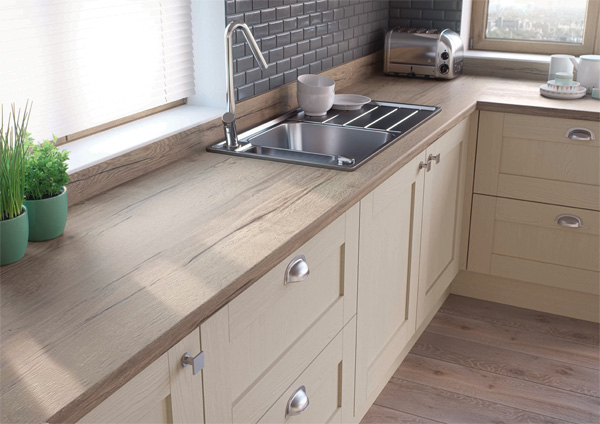
HPP- Part of the Egger Premium range is Natural Halifax Oak, which is a rustic worktop that replicates the appearance of timber. It is offered as a 38mm worktop, 19mm upstand and 10mm splashback, all of which have a square edge.
Marketing manager of HPP Dan Mounsey explains the company has “seen an increase in sales of laminated worktops of over 60% when compared to the previous financial year.”
But its popularity is not simply because laminate the cheaper option. Managing director of InHouse Wayne Dance retorts “it is easy to assume that laminate equals cheap but that’s not the right equation.”
Laminate now boasts enhanced print definition and textures, which has elevated the design aesthetic of the material.
Drawing influences from the quartz and natural stone market, laminate is not only able to mimic natural materials in décor, but can also replicate the sleek, slimlines of its thinner profile and offer textures too.
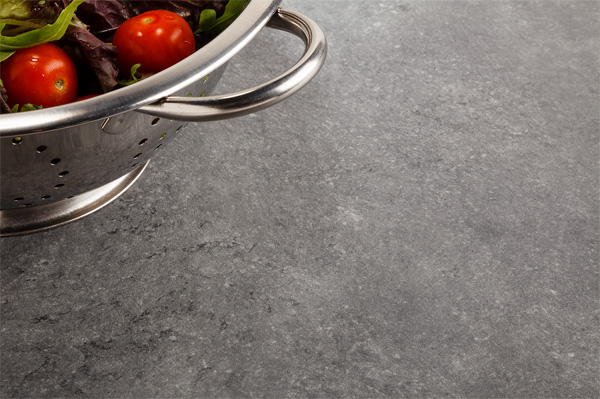
Designer Synergii Trend worktops feature a square edge and are available in single or double postform with complementary upstands and splashbacks. Pictured is the Brazilia worktop which measures 38mm thick.
Challenged by quartz
However, the market for laminate has been challenged over the past 10 years by a wider variety of materials from natural stone and timber, through to manmade solid surface and quartz.
In particular Ian Holmes of IDS cites the rise of installer ready solid surface and quartz have “nibbled away most at laminate’s market share because they enable consumers to trade up on a budget.”
It can be reflected in the sales of Maxtop Quartz. Which is a modular worktop featuring a Polypropylene honeycomb core, making it more lightweight than standard quartz surface.
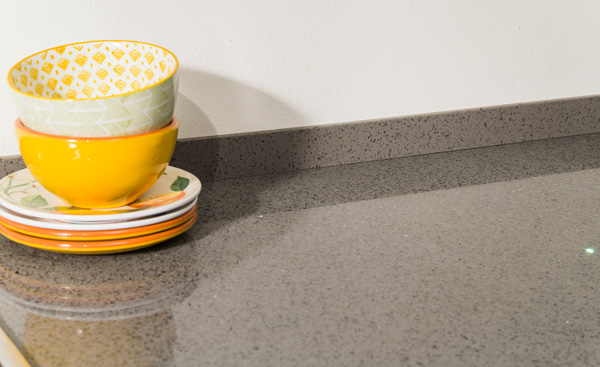
The modular Maxtop Quartz features a honeycomb core edged in 8mm solid quartz, so it is lighter and easier to install than traditional worktops, and comes in 10 colours. There is a choice of three worktop sizes, all of which come with a choice of two upstand sizes and edging as standard.
Managing director of Maxtop Quartz Stephen Moss explains: “The huge development of high rise accommodation had seen a move initially from laminate to fabricated stone and quartz”
“In the last two years, the ease of handling and lightweight nature of Maxtop has proved to be a revelation for those companies who have taken the lead in innovation”
“From a zero start two years ago, over 2,500 Maxtop Quartz worktops have already been installed throughout the UK in high rise units.”
And the upsell from laminate to quartz is a trend that is unlikely to waver.
Consumers who have perhaps experienced HPL in the past want a more prestigious and pricier work surface.
Managing director of CRL Stone Simon Boocock says greater consumer understanding, an increase in colour options and kitchen retailers upselling their customers can
Taking on top-end
But quartz is not simply a threat to the lower priced end of the market, it also has its sights on the premium market against natural and manmade stone, such as concrete.
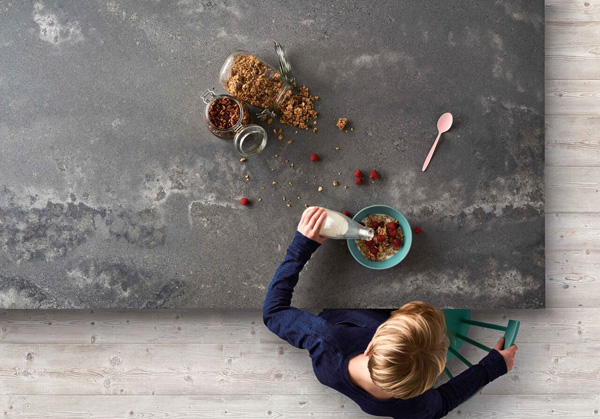
Extending its UK Collection to 44 colours, Caesarstone has introduced 4033 Rugged Concrete to meet the trend for ‘industrial chic’. It offers dark grey tones and imperfections to offer a textured look to its finish.
At one end of the scale it offers colour consistency, which by its very nature (pun intended) cannot be found in stone. While at the opposing end, it can now mimic inconsistencies of colour or veining found in granites and marbles.
Simon Boocock of CRL Stone continues: “For this reason, we are also gaining traction from customers that might have traditionally opted for natural material”
“Once a consumer understands the inherent drawbacks of natural granite and marble – the fact that it chips relatively easily and it is porous – it is easy to transition them to a material that has the same look but without any of the problems.”
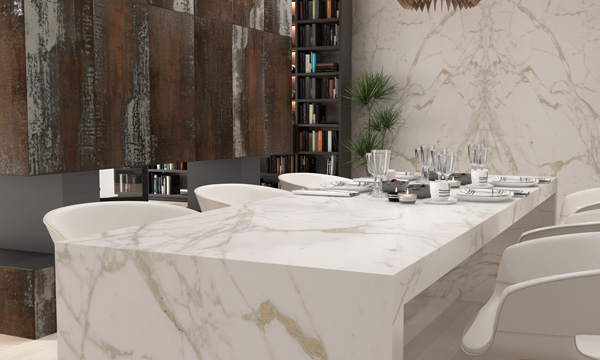
Carrara Vagli is the latest addition to the Ceralsio collection of porcelain worktops. It features a grey and gold vein to emulate the look of marble from Tuscan quarries
And Laurie Davie, marketing co-ordinator, of Cosentino UK agrees: “Particularly in demand are the marble inspired finishes, allowing customers to achieve that premium look at home without the hassle of difficult maintenance.”
In fact the company marble effects form part of both its Silestone Eternal and Dekton Natural ranges.
This trend is joined by the continuing demand for greys in interiors, with concrete also becoming an influence in worktops.
Director of Karonia, which supplies solid surface worktop brand Mistral, Andrew Pickup adds:
“We have seen sustained demand for marble-look products as well as numerous shades of grey, emulating the appearance of stone through to concrete.”
In fact, such is the growing popularity of concrete-inspired colours, Cosentino will be expanding its range to cater for demand.

Charcoal Soapstone forms one of the choices in the Silestone Eternal collection of quartz worktops. It comes in a jumbo format, is available in a Suede finish or N-Boost polished which is reported to offer a more even surface for better light reflectance and enhanced resistance against staining.
Ceramic throw down
Quartz and solid surfacing are not the only worktop material making waves in the worktop market; enter the latest technology of Fenix NTM or (Nano Tech Material).
It features a supermatt surface, meeting the trend for softened textures, and which can heal micro scratches by rubbing with a sponge or applying gentle heat.
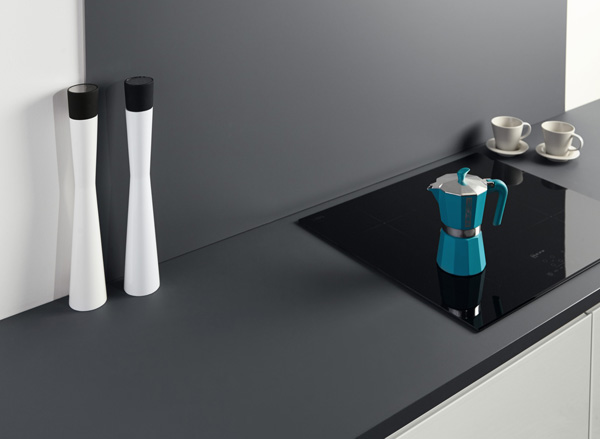
Worktops, splashbacks and breakfast bars and island components are offered in the ultra matt Fenix NTM range. It features a slimline 28mm square edged profile and comes in a choice of six colours, including Grigio Bromo (shown)
This material is joined by the likes of ceramic with thin profiles, which Simon Boocock of CRL Stone believes will actually be the next big growth area in kitchen worktops.
Wayne Dance agrees: “Thin profile ceramic worktops are immensely popular right now.”
Dance continues to explain why he believes ceramic will grow in significance for kitchen projects, and it is the ability to create a seamless finish across the kitchen:
“Ceramic surfaces capture consumer interest. The design for these surfaces is not just limited to worktops”
“Side returns, back splashed and even cabinet fronts mean the hardwearing and adaptable ceramic surface creates a new look in kitchen design”
“When thin worktop became a critical element in design, it made sense to continue the link with matching side panels and naturally when advanced manufacturing is used to create hard wearing, natural surfaces that create statement designs, another trend kicks off.”
Seamless surfacing
Certainly the wallpanelling trend has been picked up by the quartz manufacturers.
CRL Stone have introduced tiles and the likes of Cosentino promoting Dekton as a cladding both indoors and out.
And in a circular worktop journey, where we return to the laminate market, manufacturers point out such has been the evolution of the material it can now offer homogenous surfacing.
Head of UK operations at Rotpunkt UK Matt Phillips comments: “Did you know that worktops and splashbacks are now looking to furniture for inspiration with laminate solutions now available for synchronising kitchen doors, work surfaces and dividing walls in the same material and/or finish?”
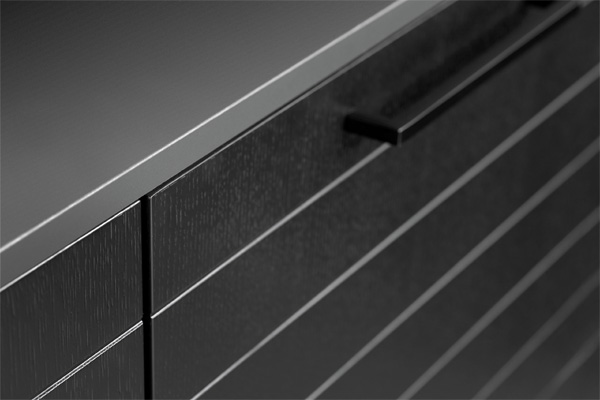
The Horizon Zerox kitchen from Rotpunkt features matt black doors, drawers and carcass in high pressure laminate. These are complemented by a 10mm thick matt black laminate worktop for a seamless look.
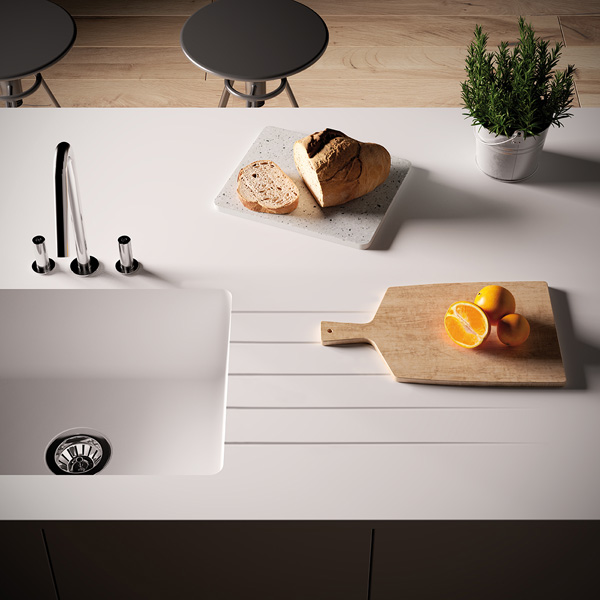
Hi-MACS solid surfacing claims to be scratch-resistant, heat-resistant and stain-resistant and is available in a matt satin finish as standard or can be ordered in a polished version. It can be assembled without visible joints and offers a range of integrated sinks.
What is clear to see in worktops is that the trends are not in isolation, but materials are inspiring colours, textures and profiles across the board.
Whatever the budget, designers can create the latest homogenous kitchen looks, sleek slimline profiles and natural affects from laminates through to quartz and ceramics.
But while these are the trends for 2018, you can be sure there will be future developments coming through in the next few years.
Marketing director of The Size, Mar Esteves Cortes, already believing thinner profiles are giving way to thicker looks.
So just as kitchen furniture evolves, expect the only horizontal touch point – the work surface – to simultaneously progress as a design statement, just to top it all off.
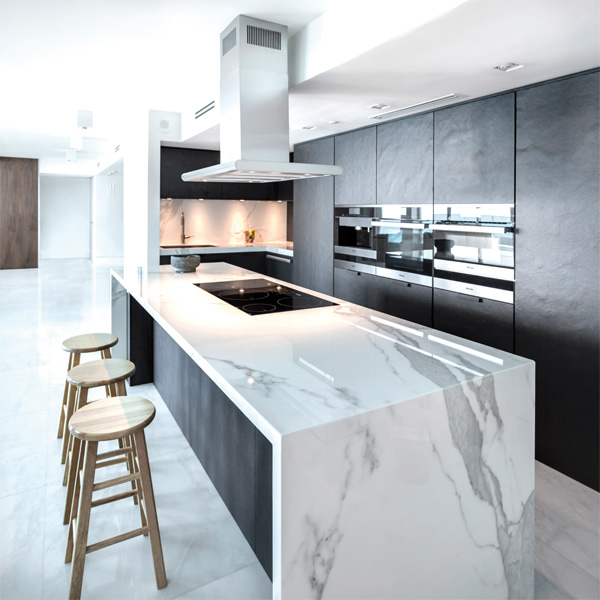
Sintered stone brand Neolith spans seven collections, which emulate stone, timber and metal, as well as offer plain colours. Pictured is Carrara marble-inspired Estaturio which comes in the choice of a Silk or Polished finish.



